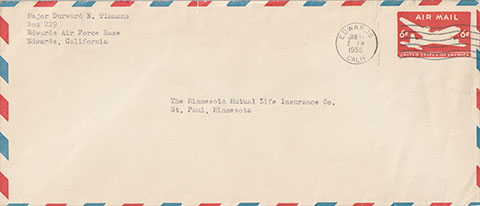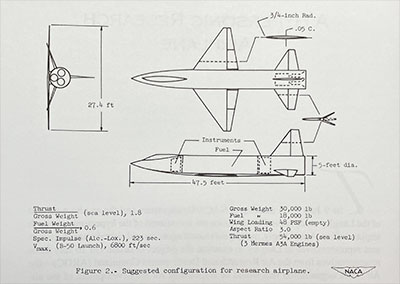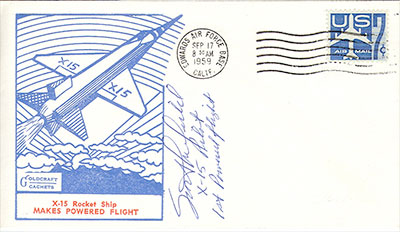|
|

|
|
Author
|
Topic: Space Cover 786: Birth of the X-15
|
micropooz
Member Posts: 1813
From: Washington, DC, USA
Registered: Apr 2003
|
 posted 12-29-2024 06:11 AM
posted 12-29-2024 06:11 AM
   
Space Cover of the Week, Week 786 (December 29, 2024) Space Cover 786: Birth of the X-15The cover above was postmarked nearly 70 years ago at Edwards AFB on January 17, 1955, the date that the US Air Force announced that their (along with NACA's and the Navy's) new hypersonic rocketplane would be known as the X-15. The next day, aerospace contractors attended a bidder's conference to begin their bids for the plane. By 1954 it had become apparent to the Air Force, Navy, and NACA that they needed another rocketplane that could go beyond the projected three-times-the-speed-of-sound (Mach 3) and altitudes of 20 miles of the yet unrealized X-2. Concepts ranged from a Mach 4.5 X-2 supplemented with solid rocket motors to a Mach 10 very-high-tech new rocketplane. In March 1954 NACA came up with a concept that served as the starting point for the X-15, shown below.  This would be a Mach 7 rocketplane, using three engines derived from the Hermes missile, launched from a B36 bomber plane. As 1954 progressed, further studies showed that the three Hermes engines were insufficient (albeit simpler) and that a more powerful throttleable engine was needed. And all three organizations gelled in their commitment to such a new rocketplane enough to make the announcement mentioned above and ask for bids from industry in January 1955. The rest of 1955 was consumed with the competition for the X-15 contract between the Bell, Douglas, North American, and Republic aircraft companies. North American was selected in August 1955 but retracted its bid before award. Some further negotiations took place, and North American signed a letter contract to begin the X-15 on December 5, 1955.  The X-15 made its first powered flight on September 17, 1959, as shown on the Goldcraft cachet cover above. As you may see from the cachet art, it carried two rocket engines. The big throttleable engine (known as the XLR-99) wasn't ready yet, so flight testing proceeded with two smaller XLR-11 engines scavenged from the prior X-1 and D-558-II programs. Even with the smaller interim engines, by October 1960, the X-15 had eclipsed the prior X-2 program records. And with the arrival of the XLR-99 engine in November 1960, the X-15 powered to the records we are all familiar with today — over Mach 6 and over 60 miles altitude. |
Bob M
Member Posts: 1973
From: Atlanta-area, GA USA
Registered: Aug 2000
|
 posted 12-30-2024 12:44 PM
posted 12-30-2024 12:44 PM
   
Very interesting and informative SCOTW about the beginning of the X-15 program, Dennis.Those of us who are fascinated by the X-15 and collect material about it, should be able to name all twelve pilots without much trouble. But maybe a pilot who was one of the first three selected to fly the X-15 and was designated the X-15 Project Test Pilot, may not be known or remembered by too many. He was Captain Iven Kincheloe, USAF, who would have certainly flown many X-15 flights. Kincheloe was a Korean War ace with five enemy kills and later a test pilot at Edwards AFB where he flew the X-2 rocket plane. In 1956 he became the first pilot to exceed 100,000 feet in altitude. But the next flight ended the X-2 Program, when the X-2 tumbled out of control, resulting in the death of Mel Apt. But the ill-fated X-2 led the way for the X-15 and Kincheloe was one of the first three pilots to be selected to fly the X-15. He perhaps would have been the first. But fate was cruel to Kincheloe, as he was killed in the crash of an F-104 at Edwards before the X-15 flew. His back-up, Bob White, then took his place and flew many X-15 flights.  This photo pictures Kincheloe in the middle, with the first man to walk on the moon on the left, and Bob White on the right. If fate had been kinder, Kincheloe may have later been one of the NASA Astronauts (two of the 12 did become NASA Astronauts) and like Armstrong, may have been one of the Apollo lunar astronauts. |
micropooz
Member Posts: 1813
From: Washington, DC, USA
Registered: Apr 2003
|
 posted 12-30-2024 01:23 PM
posted 12-30-2024 01:23 PM
   
Great point Bob! Kincheloe living to fly the X-15 is one of the more intriguing "what-if's" of the space program!Steve Durst wrote up more info on Kincheloe in SCOTW 401. And a bit more by yours truly in SCOTW 385. |
Bob M
Member Posts: 1973
From: Atlanta-area, GA USA
Registered: Aug 2000
|
 posted 12-31-2024 02:32 PM
posted 12-31-2024 02:32 PM
   
Yes, Dennis, there are many "what-if's" in aviation and space history, with it especially tragic about "Kinch," as he was called, and too many other pilots and astronauts. It was also very tragic about the death of Clifton C. Williams, with him in training to become the fourth man to walk on the moon on Apollo 12. |
Ken Havekotte
Member Posts: 3913
From: Merritt Island, Florida, Brevard
Registered: Mar 2001
|
 posted 12-31-2024 06:42 PM
posted 12-31-2024 06:42 PM
   
Now that's a historical "first" cover announcing the development of the X-15 high-speed aircraft/rocket powered research flight program in 1955. How did you ever come across it Dennis? Hard to believe that hundreds of test pilots have lost their lives here in the States since the late 1940's, with most during the 50's where it was estimated that a research (test) pilot died almost every week. Most were military and contractor pilots during that pioneering decade (1960's too) due to the early stages of aircraft jet engine and rocketplane powered technology development. As Bob said, Major Clifton Williams (USMC) had been assigned LMP for Apollo 12, but after his death in Oct. 1967, was replaced by Alan Bean in becoming the fourth lunar surface explorer in Nov. 1969. So sad that Williams along with See and Bassett were in line for a moon ticket ride, and perhaps Ted Freeman and maybe even Ed Givens. Even before Apollo, for sure, with See and Bassett originally chosen as the prime crew for Gemini 9, they most likely would had flown on Apollo as well. | |
Contact Us | The Source for Space History & Artifacts
Copyright 1999-2025 collectSPACE. All rights reserved.

Ultimate Bulletin Board 5.47a
|
|

|
 advertisement advertisement

|















